
Wake up to birdsong and buzzing bees in your backyard – make your wildlife garden dream come true! For this, read this blog post till the end. Today I’m going to share with you the chief 17 native meadow grasses to attract wildlife and they are low-maintenance too. Due to their natural grace, meadow gardens fascinate both gardeners and enthusiasts. They replicate the beauty of nature by combining:
- Wildflowers
- Flowering shrubs
- Native grass species.
You can transform your garden with low-maintenance native meadow grasses. They attract wildlife, boost biodiversity, and welcome pollinators and songbirds. Plus, other perks include improved soil health, erosion prevention, and pest protection.
So, stay tuned to explore our list and start planting these native meadow grasses to attract wildlife and embellish your orchard!
Cool Season vs Warm Season
When creating your meadow garden, consider two main types of grasses:
- Cool-Season
- Warm-Season.
Now let’s explore both of these grass types.
Cool Season Grasses
Cool season grasses prosper in temperatures between 50°F and 80°F, especially during the northern US area seasons of spring, late summer, and fall.
But during hot summers, they may go inactive and wake up in cooler temperatures.
Warm season Grasses
On the other hand, the Warm season grasses grow in warmer climates and they reach their peak height during temperatures of 80°F to 95°F.
This trait makes them best for southern states. However, in colder southern winters, they often become dormant or turn brown.

Cool & warm season grasses
What are the Meadow Grass Types?
Here I will discuss the awesome native meadow grasses to attract wildlife. So, read carefully:
1. Plains oval sedge (Carex brevior)
Meet the ultimate adaptable Plains oval sedge! This adaptable plant, which is native to most of the United States and Southern Canadian provinces, grows well in various settings. This sedge adapts easily to its environment, whether you’re growing in a grassland, wetland, or well-drained upland area.
The main specifications of this grass are as follows:
| Type: | Cool-season sedge |
| Height: | 1.2 ft. tall and 1.2 ft. wide |
| Soil Tolerance: | Dry to moist soils that drain well to moderately. |
| Sun Requirements: | Full sun to partial shade |
| Wildlife Benefits: | Food source for birds, small mammals, and insects. Habitat for beneficial insects and microorganisms |
| Maintenance: | Low |
| Drought Tolerance: | Moderate |
| Erosion Control: | Excellent |
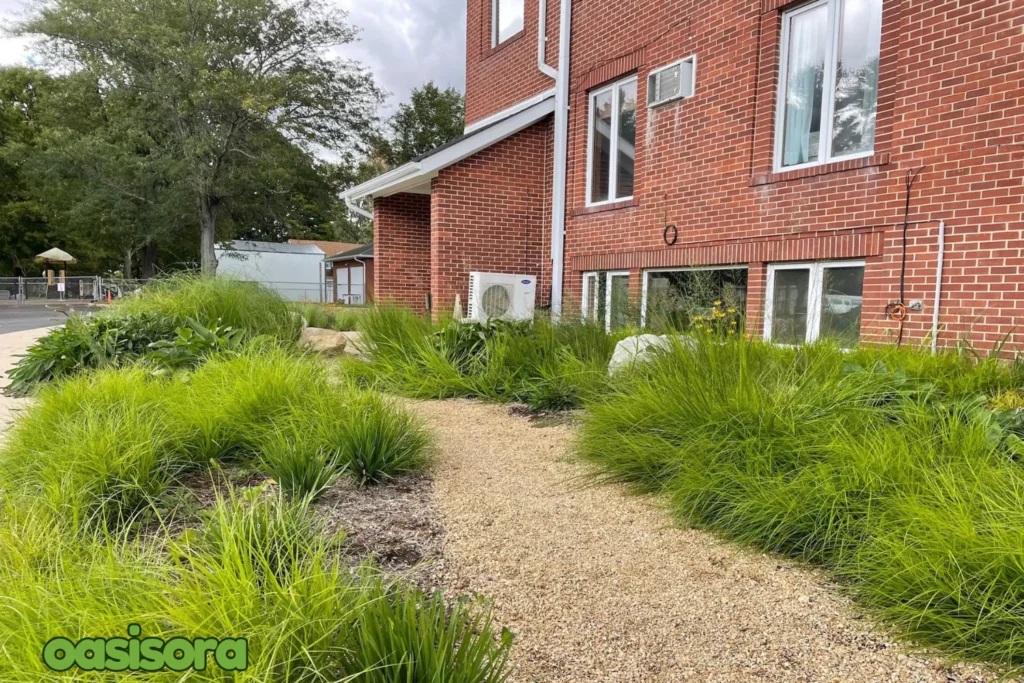
Plains oval sedge
2. Ivory sedge (Carex eburnea)
Another top pick for native meadow grasses to attract wildlife list is Bristle-Leaf Sedge.
Native to Canada and the US, this grass grows in dry, sandy soils. Its delicate, thread-like leaves are 12 inches across and tall.
This sedge thrives in drought-tolerant environments and is ideal for low-maintenance gardens and meadows.
The main specifications of this grass are as follows:
| Type: | Cool-season sedge |
| Native Region: | Eastern North America, from Canada to Virginia, west to Minnesota and Texas |
| Height: | 12″ tall, 12″ wide |
| Soil Tolerance: | Various soils |
| Sun Requirements: | Partial shade to full shade |
| USDA Zone: | 2-8 |
| Uses: | Rock gardens Accent edges for smaller landscapes Meadow design Ground cover Naturalization |
| Maintenance: | Low |
| Deer Resistance: | Yes |
| Drought Tolerance: | Moderate |
| Erosion Control: | Excellent |
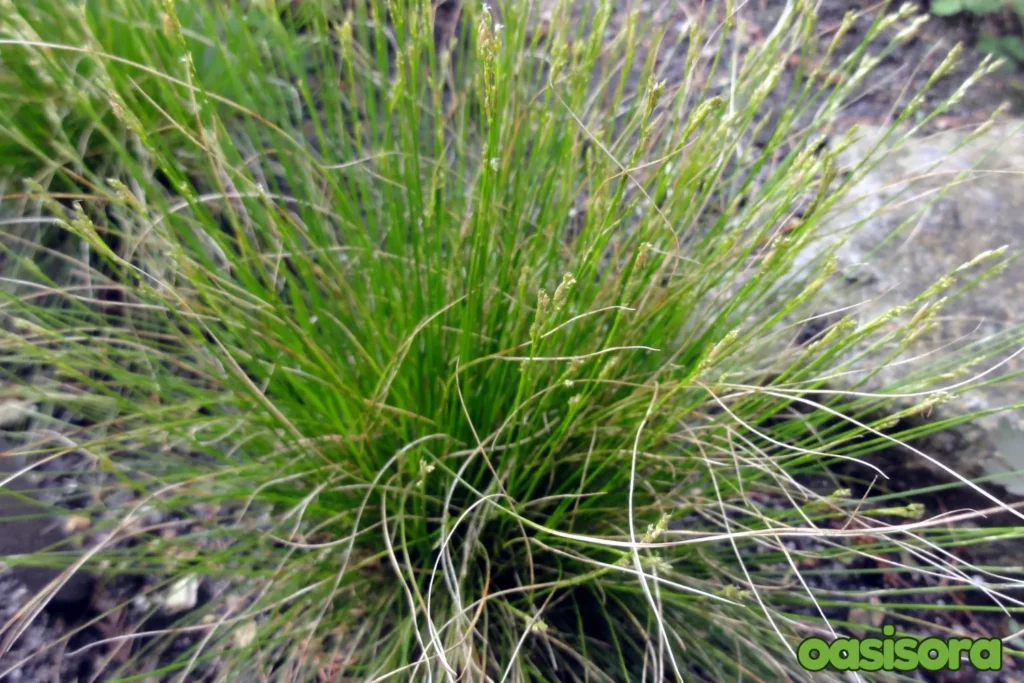
Ivory sedge (Carex eburnea)
3. Pennsylvania sedge (Carex Pensylvanica)
Also known as oak sedge, this versatile plant thrives in meadow landscapes, tolerating average to dry soils with good drainage.
Native to Eastern and Central North America, from Quebec to Manitoba and south to Mississippi and Georgia, it flourishes in shaded thickets and dry woodland areas.
The main specifications of this grass are as follows:
| Type: | Cool-season sedge |
| Native Region: | Eastern North America |
| Growth Height: | 12″ height/ 12″ wide |
| Soil Tolerance: | Dry to medium soils |
| Sun Requirements: | Partial shade to full shade |
| USDA Zone: | 3-8 |
| Uses: | Woodland gardens, meadow design, ground cover, pairs well with butterfly weed. |
| Maintenance: | Low |
| Deer Resistant: | Yes |
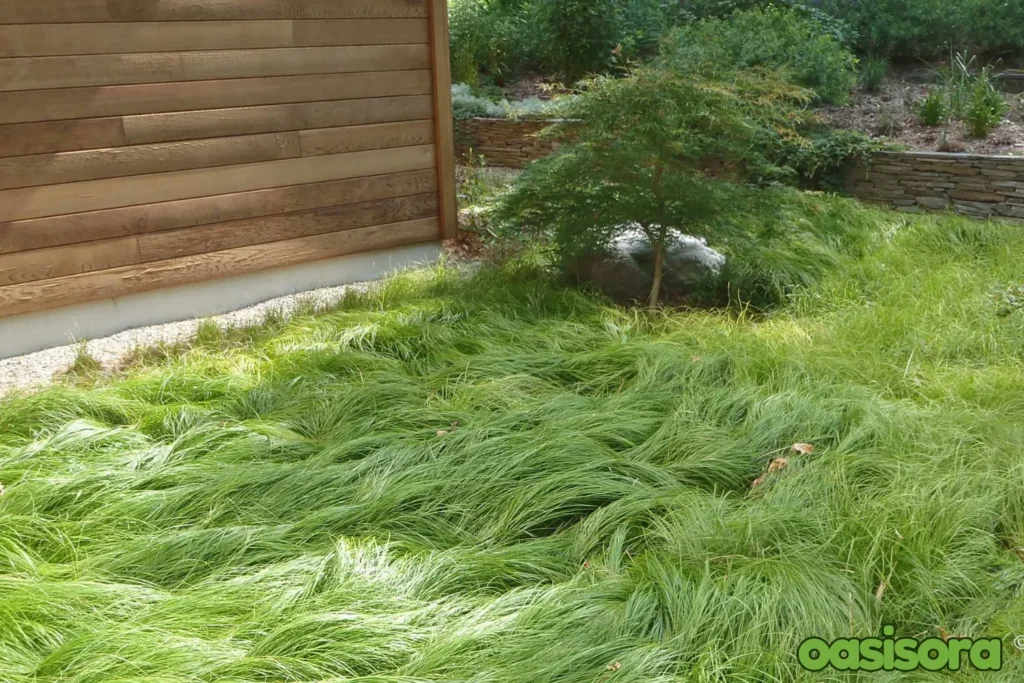
Pennsylvania sedge (Carex Pensylvanica)
4. Curly Wood Sedge (Carex rosea)
Curly wood sedge is a semi-evergreen grass that prospers in both dry and damp soil types. Such native meadow grasses to attract wildlife prosper in shaded woodlands, edges, and lush valleys.
The main specifications of this grass are as follows:
| Type: | Cool-season sedge |
| Native Region:s | Eastern North America, from Nova Scotia to Florida and west to Manitoba to Texa |
| Soil Tolerance: | Wet to dry soils |
| Sun Requirements: | Shade to partial shade |
| USDA Zone: | 4-8 |
| Uses: | Woodland gardens, meadow design, stream banks, ravines |
| Maintenance: | Low |
| Deer Resistant: | Yes |
| Drought Tolerance: | Moderate |
| Erosion Control: | Excellent |
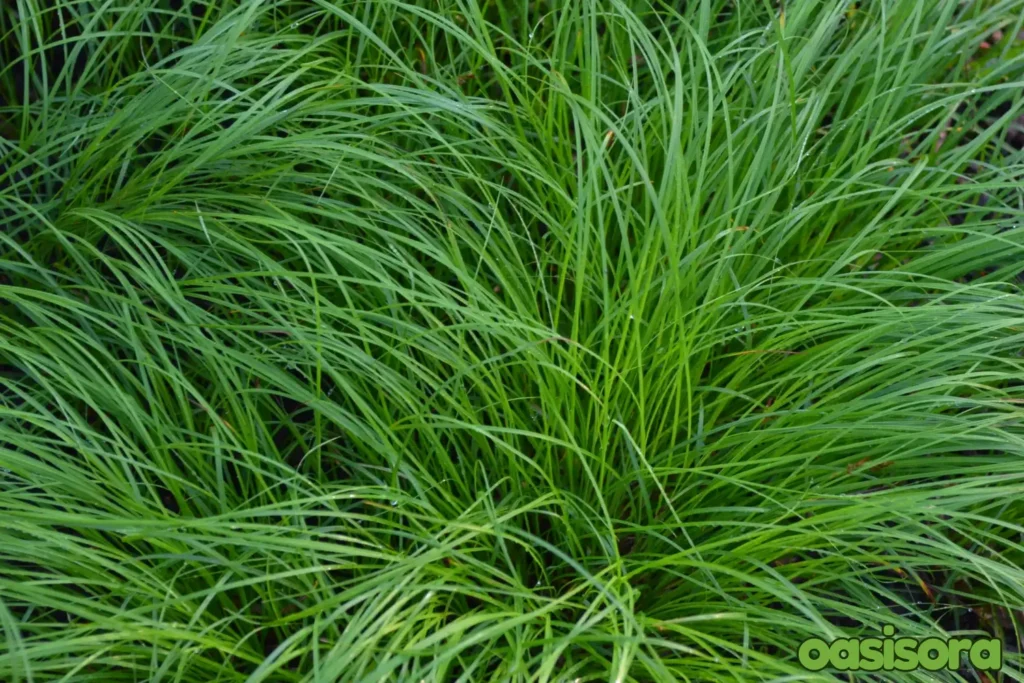
Curly Wood Sedge (Carex rosea)
5. Prairie dropseed (Sporobolus heterolepis)
Prairie Dropseed is matchless for you if you need an ageless or classic grass choice for your sunny orchard.
This authentic meadow grass blooms with soft pink and brown hues in late summer, emitting a gentle scent.
Native from Quebec to Saskatchewan and south to Colorado, Texas, and Connecticut.
Pro Tip: Famous designer Piet Oudolf features the ‘Tara’ variety in Chicago’s stunning Lurie Garden.
The main specifications of such native meadow grasses to attract wildlife are as follows:
| Type: | Warm-season grass |
| Native Region: | Central North America |
| Growth Habit: | Height 2-3’/ 2-3′ wide |
| Soil Tolerance: | Hot/dry areas, well-drained soil |
| Sun Requirements: | Full sun |
| USDA Zone: | 3-8 |
| Uses: | Groundcover Naturalized landscape Rain gardens Slopes Foundation planting Meadow design |
| Maintenance: | Low |
| Deer Tolerance: | Yes |
| Drought Tolerance: | High |
| Erosion Control: | Excellent |
| Wildlife Benefits: | Attracts butterflies, is a cold season interest, showy and fragrant |
| Water Requirements: | Water-smart |
| Companion Plants: | Butterfly Weed and Big Bluestem |

Prairie dropseed (Sporobolus heterolepis)
6. Sideoats Grama (Bouteloua Curtipendula)
Sideoats grama grasses are versatile native meadow grasses to attract wildlife. Such grasses require full Sun and thrive in various soils, from average to dry and medium, including sandy and clay. It naturally grows in sunny spots like glades, prairies, open woodlands, and railroad tracks across much of the United States.
The main specifications of this grass are as follows:
| Type: | Warm-season grass |
| Native Region: | Central and Eastern North America |
| Growth Habit: | Bunchgrass, 2.5 ft tall, 2 ft wide |
| Sun Requirements: | Full sun |
| USDA Zone: | 4-9 |
| Uses: | Massing, slopes, rock gardens, naturalized landscape, meadow design, layering with larger plants |
| Maintenance: | Low |
| Deer Tolerance: | Yes |
| Drought Tolerance: | High |
| Erosion Control: | Excellent |
| Wildlife Benefits: | Attracts birds |
| Water Requirements: | Water-smart |

Sideoats Grama (Bouteloua Curtipendula)
7. Purple lovegrass (Eragrostis pectinacea)
Love purple color? Pick Purple lovegrass native meadow grasses to attract wildlife.
This grass is found from Maine to Florida, Texas, Arizona, and Mexico. It thrives in hot, dry spots with sandy or gravelly soil.
Turn your yard into a wildlife haven by combining native Arizona trees with meadow grasses to attract local wildlife
The main specifications of this grass are as follows:
| Type: | Warm-season grass |
| USDA Zone: | 5-9 |
| Sun Requirements: | Full sun |
| Growth Habit: | Bunchgrass |
| Maintenance: | Low |
| Water Requirements: | Water-smart |
| Uses: | Massing, borders, meadow design, naturalization, great for dried flower arrangements |
| Features: | Showy flowers, Low maintenance |
| Drought tolerant: | Yes |
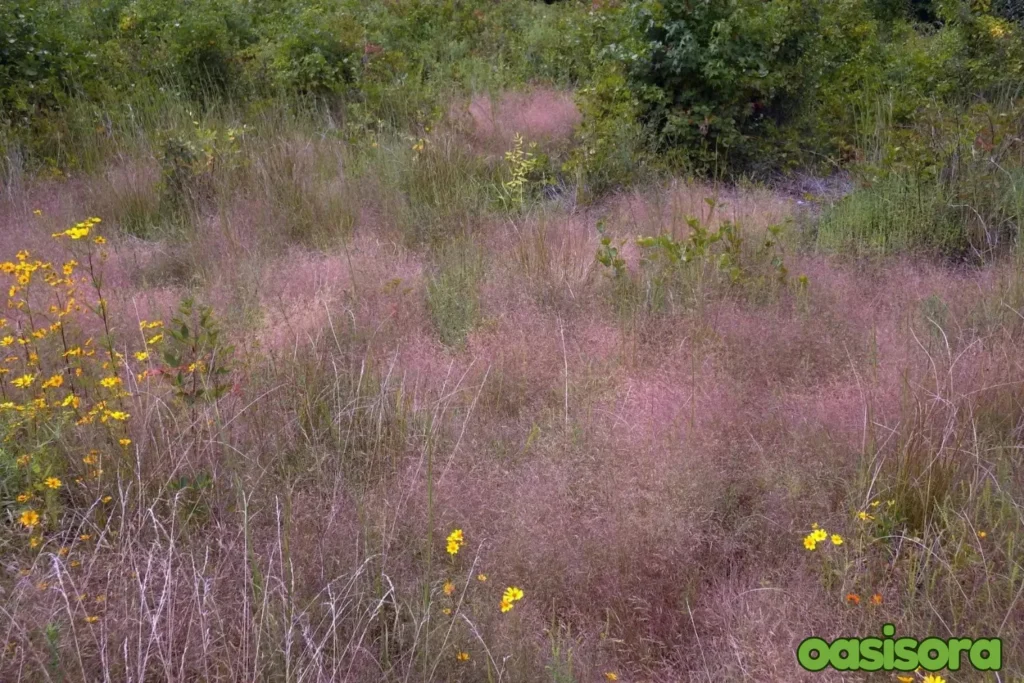
Purple lovegrass (Eragrostis pectinacea)
8. June grass (Koeleria macrantha)
You can choose June native meadow grasses to attract wildlife and enhance your yard.
Such grasses are sunny-weather and native to much of the US, except the Southeast and Northeast.
Plus, grows best in dry to medium soils with good drainage, and loves rocky or gritty ground.
Ready to create a stunning desert rock garden? Check out our latest blog on Desert Rock Garden Ideas for inspiration!.
Here are the main specifications of this grass:
| Type: | Cool-season grass |
| USDA Zone: | 3-9 |
| Sun Requirements: | Full sun |
| Growth Habit: | Height 2’/1.5′ wide |
| Soil Tolerance: | Dry to medium or well-drained soil |
| Maintenance: | Low |
| Water Requirements: | Water-smart |
| Uses: . | Naturalization, great for mixing with other ornamental meadow grasses, meadow design |
| Features: | Low maintenance, drought-tolerant, possess fascinating summer flowers |

June grass (Koeleria macrantha)
9. Northern sea oats (Chasmanthium latifolium)
My other top pick for the native meadow grasses to attract wildlife is Northern Sea Oats.
Northern Sea Oats is a low-maintenance grass that grows well in many conditions. It’s native to the eastern US and Northern Mexico.
In late spring, it blooms beautifully.
Here are the main specifications of this grass:
| Type: | Cool-season grass |
| USDA Zone: | 3-9 |
| Sun Requirements: | Full sun |
| Growth Habit: | 2 ft. tall, 1.5 ft. wide |
| Soil Tolerance: | Dry to medium, well-drained |
| Maintenance: | Low |
| Water Requirements: | Water-smart |
| Uses: | Ideal for meadow design, massing, naturalization, and mixing with other ornamental meadow grasses. |
| Features: | This grass has striking summer flowers, is drought tolerant, and requires low maintenance. |

Northern sea oats (Chasmanthium latifolium)
10. Bottlebrush grass (Elymus hystrix)
The low-maintenance bottlebrush grass is indigenous to arid wooded regions.
It is ideal for mass planting and creating texture in landscapes because it grows well in typical dry soils and partial shade.
The main specifications of such native meadow grasses to attract wildlife are as follows:
| Type: | Cool-season grass |
| USDA Zone: | 5-9 |
| Sun Requirements: | Partial shade to Full sun |
| Soil Tolerance: | Average, dry to medium, well-drained |
| Maintenance: | Low |
| Uses: | Perfect for mass planting, naturalization, or clumping in dappled woodland settings. |
| Features: | Has striking flowers, is drought- or water-smart, attracts birds, and can withstand shade. |
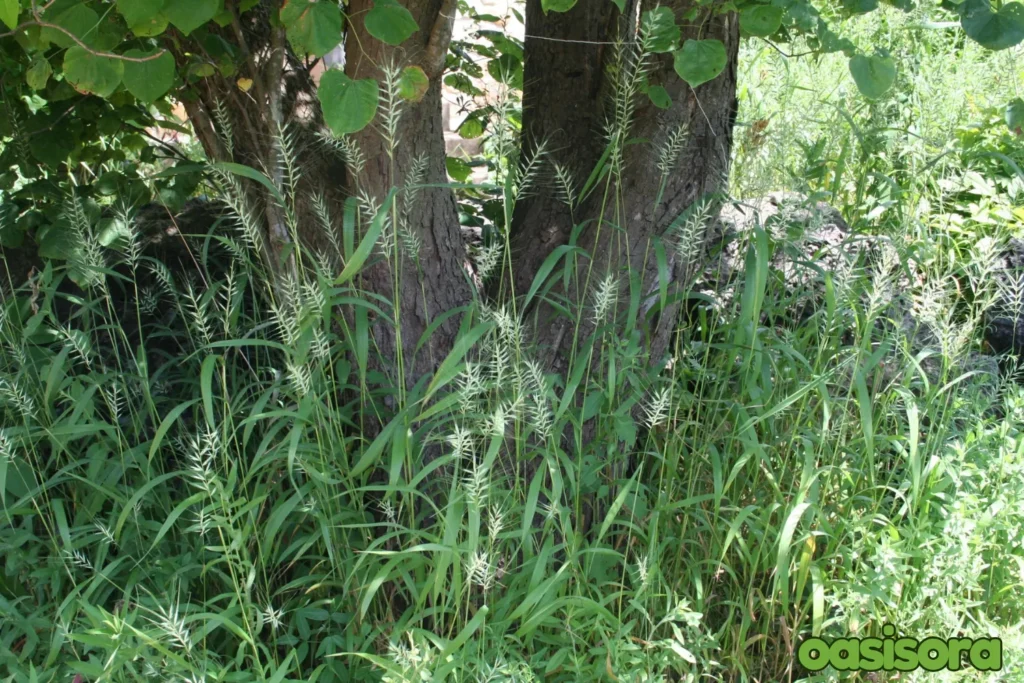
Bottlebrush grass (Elymus hystrix)
11. Little bluestem (Schizachyrium Scoparium)
Another popular native meadow grass to attract wildlife is Little Bluestem. These grasses flourish in full sun and average to dry soils with good drainage.
Originally from North America’s prairies, fields, and open woods, its range spans from Alberta to Quebec and south to Arizona and Florida.
Plus, this adaptable grass complements Big Bluestem perfectly, forming a breathtaking landscape duo.
The main specifications of such grasses are as follows:
| Type: | Warm-season grass |
| USDA Zone: | 3-9 |
| Sun Requirements: | Full sun |
| Growth Habit: | 2-4 ft tall, 1.5-2 ft wide |
| Soil Tolerance: | Dry, shallow-rocky soils |
| Maintenance: | Low |
| Uses: | Perfect for ornamental native grass gardens, borders, rock or rain gardens, meadow designs, and naturalized settings with wildflowers. |
| Features: | Cold season interest Water-smart (drought tolerant) Deer tolerant |

Little bluestem (Schizachyrium Scoparium)
12. Virginia wild rye (Elymus virginicus)
You can take your wild yard oasis to the next level with the Virginia wild rye. These native meadow grasses to attract wildlife are ideal for meadows and erosion control.
They grow well in moist soils and partial shade to full sun, covering southern Canada and eastern central US.
These are the key specs of this grass:
| Type: | Cool-season grass |
| USDA Zone: | 3-8 |
| Sun Requirements: | Full sun to partial shade |
| Height: | 2-4 ft. tall, 1-2 ft. wide |
| Soil Tolerance: | Various soils |
| Maintenance: | Low |
| Uses: | Ideal for rain gardens, slopes, hillsides, streambanks, vast naturalized landscapes, meadow designs, and erosion management. |
| Features: | Deer-resistant, attracts butterflies, great for erosion control grass. |
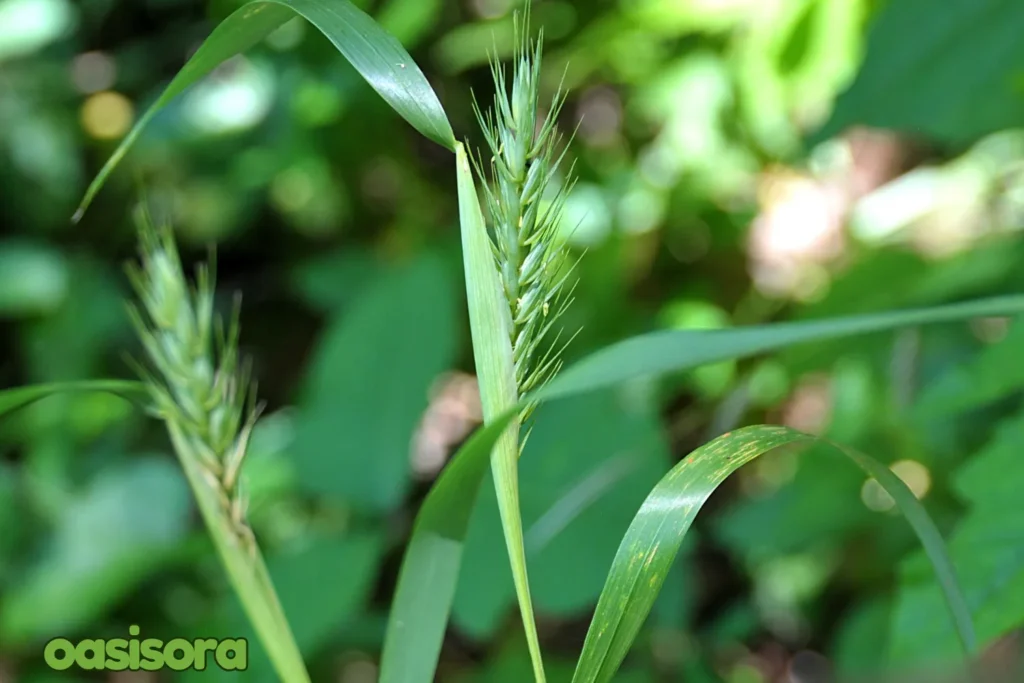
Virginia wild rye (Elymus virginicus)
13. Switchgrass (Panicum virgatum)
Switchgrass blooms in full sun to light shade and is hardy and versatile meadow grass. It grows in various soils and adds a lacy texture with its seed heads.
It breeds well in low-maintenance conditions and is indigenous to North America. If you want lovely fall leaves in your yard, try Panicum Virgatum.
Pro Tip: Pick Panicum Virgatum cultivar to add red/ purplish color to your meadow garden in the fall.
These are the key specs of this grass:
| Type: | Warm Season Grass |
| USDA Zone: | 5-9 |
| Sun Requirements: | Full sun to partially shade |
| Growth Habit: | Height 3-6′, Spread 2’-3′ |
| Soil Tolerance: | Dry to wet soils |
| Maintenance: | Low |
| Uses: | Accent meadow grasses, perennial borders, screening, mixing with wildflowers, rain gardens, and ponds. |
| Features: | Water-smart, drought-tolerant, summer-blooming, and, when dried, aesthetically pleasing. |

Switchgrass (Panicum virgatum)
14. Indian grass (Sorghastrum nutans)
Indian grass is tough and pretty. It grows well in many kinds of soil, even dry or poor soil.
It’s originally from the eastern and central United States. Plus, these native meadow grasses to attract wildlife are perfect for low-maintenance fields.
Below are the main specs of this grass type:
| Type: | Warm Season Grass |
| USDA Zone: | 4-9 |
| Sun Requirements: | Full Sun |
| Growth Height: | 3-5’/ spread 1-2′ |
| Soil Tolerance: | Shallow-rocky soils |
| Maintenance: | Medium |
| Uses: | Meadow design, naturalized landscapes, borders, vertical accent, structural matrix planting, and slope stabilization. |
| Features: | Attracts birds, visual interest in winter months, water-smart, and erosion control. |

Indian grass (Sorghastrum nutans)
15. Blue grama grass (Bouteloua gracilis)
If you desire drought-resistant grass for your wild oasis then Blue Grama is awesome for you… It tolerates various soils, excluding wet ones, and needs full sun and well-drained soil.
Following are the main specs of this amazing grass:
| Type: | Warm Season Grass |
| USDA Zone: | 3-10 |
| Sun Requirements: | Full Sun |
| Growth height: | Varies |
| Soil Tolerance: | Shallow-rocky soils |
| Maintenance: | Low |
| Uses: | Blue Grama is perfect for: Natural gardens Rock gardens Meadow designs Drought-tolerant yards Lawns Dried flower arrangements |
| Features: | Wonderful flowers, outstanding for dried arrangements, water-smart, erosion control. |

Blue grama grass (Bouteloua gracilis)
16. Big bluestem (Andropogon Gerardi)
Native to the plains of the Midwest, Big Bluestem grows from Canada to Mexico. However, it doesn’t flourish in poor or extremely dry soils. Plus, Big Bluestem is excellent for structural matrix planting.
Below are the key specs of such native meadow grasses to attract wildlife:
| Type: | Warm Season Grass |
| USDA Zone: | 4-9 |
| Sun Requirements: | Full Sun |
| Growth Habit: | Clumping |
| Soil Tolerance: | Dry to medium soils |
| Maintenance: | Low |
| Features: | Water-smart, deer-resistant, erosion-controlling, winter-interesting, and drought-tolerant. |

Big bluestem (Andropogon Gerardi)
17. Tufted Hair Grass (Deschampsia cespitosa ‘Goldtau’)
In Canada and the northern United States, from Nebraska to Iowa, Texas, and Louisiana, tufted hair grass grows well in damp to western soils.
This semi-evergreen grass naturally grows in mountain meadows, wetlands, floodplains, and marshy grasslands.
In late summer and fall, it produces stunning golden seed heads with a fuzzy texture, adding depth and visual interest to your landscapes.
Here are some specs of this grass:
| Type: | Cool Season Grass |
| USDA Zone: | 3-8 |
| Sun Requirements: | Full Sun to Part Shade |
| Soil Tolerance: | Moist to wet soils |
| Maintenance: | Low |
| Uses: | it is used in: Accent Massing Borders Rain/Rock Gardens Shade Landscapes Meadow Design. |
| Features: | It is drought-tolerant, attracts songbirds, covers lawns, and produces dried flowers. |
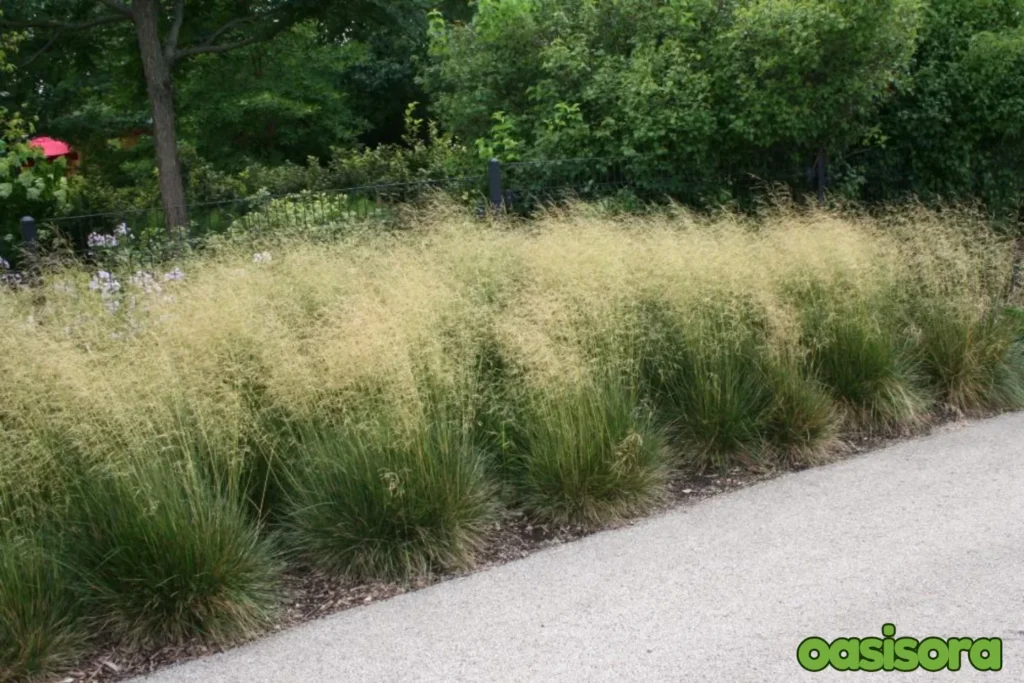
Tufted Hair Grass (Deschampsia cespitosa ‘Goldtau’)
Why Choose Native Grasses for Meadows?
Planting native meadow grasses to attract wildlife is a fantastic method for establishing a pretty habitat for native butterflies, bees, and birds:
Advantages of Native Grasses over Turf Grasses
Below are some key perks of such grasses:
Wildlife Habitat
The native grasses help wildlife to flourish by offering food and shelter to birds, cute butterflies, and perky insects. The cute and remarkable wildlife will make your outdoor space more beautiful.
Soil Health
Native grasses will help to keep soil healthy and in place. Their deep roots stop erosion, reducing soil loss and runoff. This keeps soil quality strong, supports plant growth, and benefits the environment.
Ornamental Value
Add an attractive point to your meadow yard with sparkling native grasses! They come in distinct textures, hues, and shapes. They make your outdoor space look really nice.
Planting and Preparing Your Meadow
Planning and preparation are necessary to create a stunning native meadow grass yard. What you should know is as follows:
How to Get Rid of Your Current Lawn?
It might be necessary to remove your current grass in order to begin a native meadow. Here’s how:
- Cutting: Cut the grass short
- Removing: Remove dead grass and debris
- Applying: Apply a non-selective herbicide (if needed)
- Tilting: Tilt the soil to loosen it.
How to Plant a Native Meadow?
You can plant a native meadow using:
- Seeds: Spread seeds evenly and rake them in
- Plugs: Plant small plants 6-12 inches apart
- Larger plants: Space them according to their need
Soil Preparation and Selecting the Right Grass
You can establish a stunning and prosperous native meadow by using these strategies and pointers.
- Get the soil ready: check out the soil type and also the pH level in your yard.
- Pick the appropriate grass: Choose natural grasses suitable for your soil type and yard’s temperature zones.
How to Use Native Meadow Grasses in a Backyard Design?

Native Meadow Grasses in a Backyard
Native meadow grasses to attract wildlife can also boost the aesthetic appeal of your outdoor oasis. Here’s how to incorporate them in your garden:
Designing a Wildlife-Friendly Meadow
Here’s how to create a wildlife-friendly meadow:
- Pick native grasses that fit your area.
- Think about the space size.
- Add logs, rocks, or sticks for wildlife homes.
Using Grasses in Layers for a Visually Appealing Layout
Create visual interest by layering:
- Short grasses (6-12 inches) for borders or foregrounds.
- Medium grasses (2-3 feet) for mid-ground texture.
- Tall grasses (4-6 feet) for the yard’s background or its focal points.
Mixing Grasses for Year-Round Interest
Combine different native grass species to:
- Give wildlife food and shelter all year.
- Make your landscape look interesting with different textures and colors.
- Help local wildlife and the environment thrive.
This will create a beautiful and helpful meadow for both you and nature.
Maintaining Your Native Meadow
Here are some effortless tips to maintain your native meadow grasses to attract wildlife:
Mowing Schedule
Here’s how to mow your meadow to keep plants healthy and protect wildlife:
- Mow in late winter or early spring.
- Mow high to protect plants and wildlife.
- Don’t mow too often to let plants grow.
Managing Invasive Species
For this, you can follow these tips:
- Pull or dig up invasive plants.
- Use some organic herbicides to avoid harming native grasses.
- Monitor your meadow regularly.
Encouraging Reseeding and Natural Growth
Lastly, let’s read about seed health and how to encourage the natural growth of them:
- Let plants go to seed.
- Don’t over-mow or over-water.
- Give your meadow some breathing room!
You should overdo watering with the mower or can. Just let nature do its thing. Easy peasy, and your meadow will stay happy and healthy!.
Final Words
Using native meadow grasses is a simple and effective way to create a wildlife garden.
The 17 grasses shown here offer many benefits, including attracting birds and butterflies and helping with drought and erosion.
Incorporating these low-maintenance grasses into your landscape enhances biodiversity while creating a serene outdoor retreat. Start your landscape transformation today!
Enhance your front yard by incorporating native meadow grasses and rocks to attract wildlife, creating a vibrant and welcoming space for both nature and beauty

12 thoughts on “17 Best Native Meadow Grasses to Attract Wildlife”
Comments are closed.